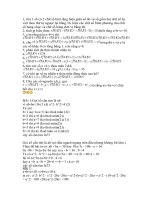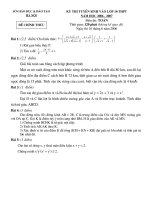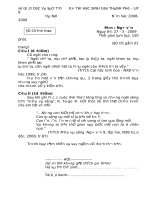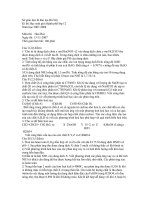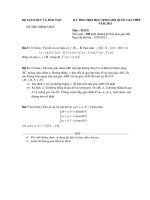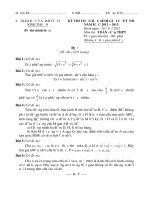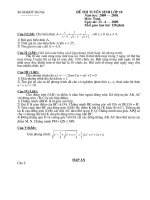Đề thi Toán học Hà Nội mở rộng HOMC năm 2016
Bạn đang xem bản rút gọn của tài liệu. Xem và tải ngay bản đầy đủ của tài liệu tại đây (145.62 KB, 6 trang )
<span class='text_page_counter'>(1)</span><div class='page_container' data-page=1>
Hanoi Open Mathematical Competition 2016
Junior Section
Important:
Answer to all 15 questions.
Write your answers on the answer sheets provided.
For the multiple choice questions, stick only the letters (A, B, C, D or E) of your
choice.
No calculator is allowed.
Question 1. If
2016 = 25+ 26+· · ·+ 2m,
then m is equal to
(A): 8 (B): 9 (C): 10 (D): 11 (E): None of the above.
Anwser. (C).
Question 2. The number of all positive integers n such that
n+s(n) = 2016,
wheres(n) is the sum of all digits of n, is
(A): 1 (B): 2 (C): 3 (D): 4 (E): None of the above.
Anwser. (B): n = 1989,2007.
Question 3. Given two positive numbers a, bsuch that a3<sub>+</sub><sub>b</sub>3 <sub>=</sub><sub>a</sub>5<sub>+</sub><sub>b</sub>5<sub>,</sub><sub>then the</sub>
greatest value of M =a2<sub>+</sub><sub>b</sub>2 <sub>−</sub><sub>ab</sub> <sub>is</sub>
(A): 1
4 (B):
1
2 (C): 2 (D): 1 (E): None of the above.
Anwser. (D).
Question 4. A monkey in Zoo becomes lucky if he eats three different fruits.
What is the largest number of monkeys one can make lucky, by having 20 oranges,
30 bananas, 40 peaches and 50 tangerines? Justify your answer.
(A): 30 (B): 35 (C): 40 (D): 45 (E): None of the above.
Anwser. (D).
</div>
<span class='text_page_counter'>(2)</span><div class='page_container' data-page=2>
(A): 2013 (B): 2014 (C): 2015 (D): 2016 (E): None of the above.
Anwser. (E).
Question 6. Determine the smallest positive number a such that the number of
all integers belonging to (a,2016a] is 2016.
Solution. The smallest integer greater thana is [a] + 1 and the largest integer less
than or is equal to 2016a is [2016a]. Hence, the number of all integers belonging to
(a,2016a] is [2016a]−[a].
Now we difine the smallest positive number a such that
[2016a]−[a] = 2016.
If 0< a≤1 then [2016a]−[a]<2016.
If a≥2 then [2016a]−[a]>2016.
Let a = 1 + b, where 0 < b < 1. Then [a] = 1, [2016a] = 2016 + [2016b] and
[2016a]−[a] = 2015 + [2016b] = 2016 iff [2016b] = 1. Hence the smallest positive
number b such that [2016b] = 1 is b= 1
2016.
Thus, a = 1 + 1
2016 is a smallest positive number such that the number of all
integers belonging to (a,2016a] is 2016.
Question 7. Nine points form a grid of size 3×3. How many triangles are there
with 3 vetices at these points?
Solution. We divide the triangles into two types:
Type 1: Two vertices lie in one horizontal line, the third vertice lies in another
horizontal lines.
For this type we have 3 possibilities to choose the first line, 2 posibilities to choose
2nd line. In first line we have 3 possibilities to choose 2 vertices, in the second line
we have 3 possibilities to choose 1 vertex. In total we have 3×2×3× 3 = 54
triangles of first type.
Type 2: Three vertices lie in distinct horizontal lines.
We have 3×3×3 triangles of these type. But we should remove degenerated
triangles from them. There are 5 of those (3 vertical lines and two diagonals). So,
we have 27 - 5 = 22 triangles of this type.
Total we have 54 + 22 = 76 triangles.
For those students who know aboutCk
n this problem can be also solved asC93−8
where 8 is the number of degenerated triangles.
Question 8. Find all positive integers x, y, z such that
</div>
<span class='text_page_counter'>(3)</span><div class='page_container' data-page=3>
Solution. Puttingy+z =a, a∈<sub>Z</sub>, a≥2, we have
x3−a3 = (x+a)2+ 34. (1)
⇔(x−a) x2+xa+a2=x2+ 2ax+a2+ 34. (2)
⇔(x−a−1) x2+xa+a2=xa+ 34.
Since x, a are integers, we have x2 +xa+a2 ≥ 0 and xa+ 34 > 0. That follow
x−a−1>0, i.e. x−a≥2.
This and (2) together imply
x2+ 2ax+a2+ 34≥2 x2+xa+a2⇔x2+a2 ≤34.
Hence x2 <sub><</sub><sub>34 and</sub><sub>x <</sub><sub>6</sub><sub>.</sub>
On the other hand, x≥a+ 2 ≥4 thenx∈ {4,5}.
If x= 5, then fromx2+a2 ≤34 it follows 2 ≤a ≤3. Thus a∈ {2,3}.
The case of x= 5, a = 2 does not satisfy (1) for x= 5, a= 3, from (1) we find
y= 1, z = 2 or y= 2, z= 1,
If x= 4, then from the inequalityx−a≥2 we finda≤2, which contradicts to
(1).
Conclusion: (x, y, z) = (5,1,2) and (x, y, z) = (5,2,1).
Question 9. Let x, y, z satisfy the following inequalities
|x+ 2y−3z| ≤6
|x−2y+ 3z| ≤6
|x−2y−3z| ≤6
|x+ 2y+ 3z| ≤6
Determine the greatest value ofM =|x|+|y|+|z|.
Solution. Note that for all real numbers a, b, c,we have
|a|+|b|= max{|a+b|,|a−b|}
and
|a|+|b|+|c|= max{|a+b+c|,|a+b−c|,|a−b−c|,|a−b+c|}.
Hence
M =|x|+|y|+|z| ≤ |x|+ 2|y|+ 3|z|=|x|+|2y|+|3z|
= max{|x+y+z|,|x+y−z|,|x−y−z|,|x−y+z|} ≤6.
</div>
<span class='text_page_counter'>(4)</span><div class='page_container' data-page=4>
Question 10. Let ha, hb, hc and r be the lengths of altitudes and radius of the
inscribed circle of ∆ABC, respectively. Prove that
ha+ 4hb+ 9hc>36r.
Solution. Leta, b, cbe the side-lengths of ∆ABC corresponding to ha, hb, hc and
S be the area of ∆ABC. Then
aha=bhb =chc= (a+b+c)×r= 2S.
Hence
ha+ 4hb+ 9hc=
2S
a =
8S
b =
18S
c = 2S
12
a +
22
b +
32
c
≥2S(1 + 2 + 3)
2
a+b+c
= (a+b+c)r(1 + 2 + 3)
2
a+b+c = 36r.
The equality holds iff a:b:c= 1 : 2 : 3 (it is not posible for a+b > c).
Question 11. Let be given a triangle ABC and let I be the middle point of BC.
The straight lined passingI intersectsAB, AC atM, N, respectively. The straight
line d0 (6≡ d) passingI intersectsAB, AC atQ and P, respectively. Suppose M, P
are on the same side of BC and M P, N Q intersect BC at E and F, respectively.
Prove thatIE =IF.
Solution. Since IB=IC then it is enough to show EB
EC =
F C
F B.
By Menelaus theorem:
- For ∆ABC and three points E, M, P, we have
EB
EC ×
P C
P A ×
M A
M B = 1
then
EB
EC =
P A
P C ×
M B
M A. (1)
- For ∆ABC and three points F, N, Q, we have
F C
F B ×
QB
QA ×
N A
N C = 1
then
F C
F B =
N C
N A ×
QA
QB. (2)
- For ∆ABC and three points M, I, N,we have
M B
M A ×
N A
N C ×
</div>
<span class='text_page_counter'>(5)</span><div class='page_container' data-page=5>
Compare with IB=IC we find
M B
M A =
N C
N A. (3)
- For ∆ABC and three points Q, I, P, we have
P A
P C ×
IC
IB ×
QB
QA = 1
then
P A
P C =
QA
QB. (4)
Equalities (1), (2), (3) and (4) toghether imply IE =IF.
Question 12. In the trapezoid ABCD, AB k CD and the diagonals intersect at
O. The points P, Q are on AD, BC respectively such that <sub>∠</sub>AP B = <sub>∠</sub>CP D and
∠AQB =<sub>∠</sub>CQD. Show that OP =OQ.
Solution. ExtendingDAtoB0such thatBB0 =BA, we find<sub>∠</sub>P B0B =<sub>∠</sub>B0AB=
∠P DC and then triangles DP C and B0P B are similar.
It follows that DP
P B0 =
CD
BB0 =
CD
BA =
DO
BO and soP O kBB
0<sub>.</sub>
Since triangles DP O and DB0B are similar, we have
OP =BB0× DO
DB =AB×
DO
DB.
Similarly, we haveOQ=AB× CO
CA and it follows OP =OQ.
Question 13. Let H be orthocenter of the triangle ABC. Let d1, d2 be lines
perpendicular to each-another atH.The line d1 intersectsAB, AC atD, E and the
lined2 intersectsBC atF.Prove thatH is the midpoint of segment DE if and only
if F is the midpoint of segmentBC.
Solution. Since HD ⊥ HF, HA ⊥ F C and HC ⊥ DA,<sub>∠</sub>DAH = <sub>∠</sub>HCF and
∠DHA=<sub>∠</sub>HF C, therefore the triangles DHA, HF C are similar.
So HA
HD=
F C
F H (1)
Similarly, 4EHA<sub>v</sub>4HF B,so HE
HA =
F H
F B (2)
From (1) and (2), obtained HE
HD=
F C
F B.
It followsHis midpoint of the segmentDE iffF is midpoint of the segmentBC.
</div>
<span class='text_page_counter'>(6)</span><div class='page_container' data-page=6>
Solution. From equality
2015a2+a= 2016b2+b, (1)
we find a≥b.
If a=b then from (1) we have a=b= 0 and √a−b= 0.
If a > b, we write (1) as
b2 = 2015(a2−b2) + (a−b)⇔b2 = (a−b)(2015a+ 2015b+ 1). (2)
Let (a, b) =d then a=md, b=nd, where (m, n) = 1. Since a > b then m > n,
and put m−n =t >0.
Let (t, n) =u thenn is divisible by u, t is divisible by uand m is divisible by u.
That followsu= 1 and then (t, n) = 1.
Putting b=nd, a−b =td in (2), we find
n2d=t(2015dt+ 4030dn+ 1). (3)
From (3) we get n2dis divisible by t and compaire with (t, n) = 1, it followsd is
divisible by t.
Also from (3) we getn2<sub>d</sub><sub>= 2015</sub><sub>dt</sub>2<sub>+ 4030</sub><sub>dnt</sub><sub>+</sub><sub>t</sub> <sub>and then</sub> <sub>t</sub><sub>=</sub><sub>n</sub>2<sub>d</sub><sub>−</sub><sub>2015</sub><sub>dt</sub>2<sub>−</sub>
4030dnt.
Hence t =d(n2<sub>−</sub><sub>2015</sub><sub>t</sub>2 <sub>−</sub><sub>4030</sub><sub>nt</sub><sub>)</sub><sub>,</sub> <sub>i.e.</sub> <sub>t</sub> <sub>is divisible by</sub> <sub>d,</sub> <sub>i.e.</sub> <sub>t</sub> <sub>=</sub> <sub>d</sub> <sub>and then</sub>
a−b=td=d2 <sub>and</sub> √<sub>a</sub><sub>−</sub><sub>b</sub> <sub>=</sub><sub>d</sub> <sub>is a natural number.</sub>
Question 15. Find all polynomials of degree 3 with integer coefficients such that
f(2014) = 2015, f(2015) = 2016,and f(2013)−f(2016) is a prime number.
Solution. Let g(x) = f(x)−x−1. Then g(2014) = f(2014)−2014−1 = 0,
g(2015) = 2016−2015−1 = 0. Hence g(x) = (ax+b)(x−2014)(x−2015) and
f(x) = (ax+b)(x−2014)(x−2015) +x+ 1, a, b∈<sub>Z</sub>, a6= 0.
We havef(2013) = 2(2013a+b) + 2014 and
f(2016) = 2(2016a+b) + 2017.
That follows
f(2013)−f(2016) = 2(2013a+b) + 2014−[2(2016a+b) + 2017]
=−6a−3 = 3(−2a−1)
and f(2013)−f(2016) is prime iff −2a−1 = 1, i.e. a=−1.
Conlusion: All polynomials of degree 3 with integer coefficients such thatf(2014) =
2015, f(2015) = 2016 and f(2013)−f(2016) is a prime number are of the form
</div>
<!--links-->

